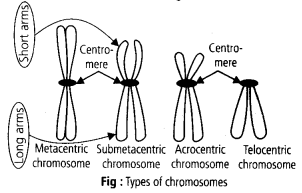NCERT Solutions For Class 11 Biology Cell The Unit of Life
Topics and Subtopics in NCERT Solutions for Class 11 Biology Chapter 8 Cell The Unit of Life :
| Section Name | Topic Name |
| 8 | Cell The Unit of Life |
| 8.1 | What is a Cell? |
| 8.2 | Cell Theory |
| 8.3 | An Overview of Cell |
| 8.4 | Prokaryotic Cells |
| 8.5 | Eukaryotic Cells |
| 8.6 | Summary |
NCERT Solutions Class 11 Biology Biology Sample Papers
NCRT TEXTBOOK QUESTIONS SOLVED
1.Which of the following is not correct?
(a) Robert Brown discovered the cell.
(b) Schleiden and Schwann formulated the cell theory.
(c) Virchow explained that cells are formed from pre-existing cells.
(d) A unicellular organism carries out its life activities within a single cell.
Soln.
(a) Robert Hooke discovered the celland Robert Brown discovered nucleus in the cell.
2.New cells generate from
(a) bacterial fermentation
(b) regeneration of old cells
(c) pre-existing cells
(d) abiotic materials.
Soln.
(c)
More Resources for CBSE Class 11
- NCERT Solutions
- NCERT Solutions Class 11 Maths
- NCERT Solutions Class 11 Physics
- NCERT Solutions Class 11 Chemistry
- NCERT Solutions Class 11 Biology
- NCERT Solutions Class 11 Hindi
- NCERT Solutions Class 11 English
- NCERT Solutions Class 11 Business Studies
- NCERT Solutions Class 11 Accountancy
- NCERT Solutions Class 11 Psychology
- NCERT Solutions Class 11 Entrepreneurship
- NCERT Solutions Class 11 Indian Economic Development
- NCERT Solutions Class 11 Computer Science
3.Match the following.
Column I Column II
(a) Cristae (i) Flat membranous
sacs in stroma
(b) Cisternae (ii) Infoldings in
mitochondria
(c) Thylakoids (iii) Disc-shaped sacs in
Golgi apparatus
Soln
.a – (ii); b – (iii); c – (i).
4.Which of the following is correct?
(a) Cells of all living organisms have a nucleus.
(b) Both animal and plant cells have a well defined cell wall.
(c) In prokaryotes, there are no membrane bound organelles.
(d) Cells are formed de novo from abiotic
Soln.
(c) Mature mammalian erythrocytes and sieve tube cells of vascular plants lack nucleus. Animals lack cell wall and only cell membrane is present. Prokaryotes are unicellular organisms which lack nucleus and other membrane bound organelles. All cells arise from pre-existing cells.
5.What is a mesosome in a prokaryotic cell? Mention the functions that it performs.
Soln.
Mesosome is a membranous structure in prokaryotic cell, which is formed by the extensions of the plasma membrane into the cell in form of vesicles, tubules and lamellae. Mesosomes are equal to mitochondria in eukaryotes, as they perform aerobic cellular respiration in prokaryotes. It helps in DNA replication and distribution of genetic material to daughter cells. Mesosomes also help in respiration, increase the surface area of the plasma membrane and enzymatic content and cell wall formation.
6.How do neutral solutes move across the plasma membrane? Can the polar molecules also move across it in the same way? If not, then how are these transported across the membrane?
Soln.
Neutral solutes move across the membrane by the process of simple diffusion along the concentration gradient i.e., from higher concentration to the lower concentration. Polar molecules cannot pass through the nonpolar lipid bilayer, they require carrier proteip of the membrane to facilitate their transport across the membrane. In facilitated diffusion, molecules are transported along concentration gradient by help of ion channels and permeases and it does not involve energy expenditure (passive transport).
7. Name two cell-organelles that are double membrane bound. What are the characteristics of these two organelles? State their functions and draw labelled diagrams of both?
Solution:
Mitochondria and chloroplast are double membrane bound organelles. Mitochondria: Mitochondria are cylindrical or sausage shaped cell organelles and contains two membranes, outer and inner. The inner compartment is called the matrix containing DNA, RNA, ribosomes, enzymes of Krebs cycle etc and outer membrane forms the continuous limiting boundary of the organelle. Inner membrane forms number of infoldings called the cristae which increases the surface area. Oxysomes are present on inner mitochondrial membrane. Mitochondria are semiautonomous organelles, i.e., have their own DNA and ribosomes.
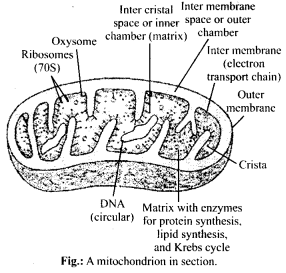
Functions of mitochondria:
- Mitochondria are essential for aerobic respiration.
- Mitochondria provide intermediates for synthesis of important biomolecules such as chlorophyll, cytochrome, steroids etc.
- Mitochondria regulate the calcium ion concentration in the cell.
- Mitochondrial matrix contains enzymes for the synthesis of fatty acids.
- Synthesis of many amino acids takes place here
Chloroplast: They are green coloured plastids which are disc shaped. The space limited by inner membrane of chloroplast is called as stroma. Stroma has organised flattened membranous sacs called the thylakoids. Thylakoids are arranged in stacks called grana. Matrix of a chloroplast contains DNA, RNA, ribosomes and enzymes. Chloroplast is also a semiautonomous organelle.
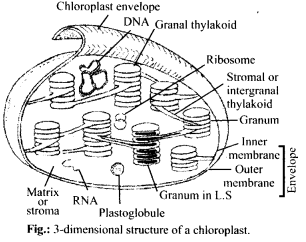
Functions of chloroplast:
- Photosynthesis is performed by chloroplast.
- Chloroplast stores starch grains.
- Maintains balance of C02 concentration in the air.
- Keeps oxygen balance constant in atmosphere by liberating 02 into the atmosphere, used during respiration and combustion.
8.What are the characteristics of prokaryotic
cells?
Solution:
Characteristics of prokaryotic cells are as follows:
- The prokaryotic cell is essentially a single – envelope system.
- Prokaryotes lack membrane bound cell organelles.
- Prokaryotes have 70S ribosomes.
- DNA is naked and lies coiled in cytoplasm. It is not covered by nuclear membrane and is termed as nucleoid.
- Nuclear components, like, nuclear envelope, nucleolus, nucleoplasm are absent.
- Cell wall is present in bacteria and cyanobacteria, but absent in mycoplasma.
- Multiplies by asexual reproduction.
- Transcription and translation takes place in cytoplasm.
9.Multicellular organisms have division of labour. Explain.
Soln.
Division of labour is differentiation of certain components or parts to perform different functions for increased efficiency and higher survival. Multicellular organisms often possess millions of cells. Various cells are grouped together to form specific tissue, organ or organ system, with each specialised to perform particular function. Every cell of a multicellular organism cannot obtain food from outside. The organism requires a system for obtaining food, its digestion and distribution. Therefore, a digestive system and system of transport are also required. Certain cells of the body take over the function of reproduction. Others take part in repair and replacement of worn out or injured portions. For optimum functioning of cells, a multicellular organism also requires an internal favourable environment. Therefore, multicellular organisms come to have division of labour.
10.Cell is the basic unit of life. Discuss in brief.
Soln.
Cell is fundamental, structural and functional unit of life, as no living organism can have life without being cellular. All life begins as a single cell. An organism is either made of single cell (unicellular) or many cells (multicellular). In unicellular organism, single cell is capable of independent existence and perform all essential functions of life, while in multicellular organism, each group of cells is specialised for specific function. Life passes from one generation to the next in form of cells, and new cell always arise from division of pre-existing cells. Cells are totipotent, i.e., single cell has ability to form whole organism. The activities of an organism are sum total of activities of its cells, therefore, cell is the basic unit of life.
11.What are nuclear pores? State their function.
Soln.
Nuclear envelope bounds the nucleus from outside and separates it from cytoplasm. It consists of two membranes, with outer membrane continuous with endoplasmic reticulum. The nuclear envelope is interrupted by minute nuclear pores, at a number of places, which are produced by the fusion of its two membranes. These
nuclear pores are the passages through which movement of RNA and protein molecules takes place in both directions between the nucleus and the cytoplasm.
12.Both lysosomes and vacuoles are endomem-brane ‘structures, yet they differ in terms of their functions. Comment.
Soln.
Organelles of endomembrane system such as lysosome and vacuoles function in close coordination with one another but are specialised to perform different functions. Lysosomes breakdown the ageing and dead cells, they help in digestion of food as they contain hydrolytic digestive enzymes. They are involved in cell division also. Vacuoles on other hand, help in excretion and osmoregulation in Amoeba (contractile vacuole) or provides buoyancy, mechanical strength in prokaryotes (air vacuoles).
13.Describe the structure of the following with
the help of labelled diagrams.
(i) Nucleus (ii) Centrosome
Soln.
(i) Nucleus: Nucleus is double membrane bound principle cell organelle which contains all genetic information for controlling cellular metabolism and transmission of genetic information.
Nucleus is differentiated into following four parts:
(a) Nuclear envelope: It is a double membrane bound envelope that surround the nucleus and separates the latter from the cytoplasm.
(b) Nucleoplasm: Itis clear, non-staining, fluid material present in the nucleus, which contains raw materials (nucleotides), enzymes (DNA/RNA polymerases) and metal ions for the synthesis of RNAs and DNA. The nuclear matrix or the nucleoplasm is composed of nucleolus and chromatin.
(c) Nucleolus: It is a naked, round and slightly irregular structure, which is attached to the chromatin at a specific region. It is a site for active ribosomal RNA synthesis.
(d) Chromatin : It has the ability to get stained with certain basic dyes. It is known to be the hereditary DNA protein fibrillar complex. The chromatin fibres are distributed throughout the nucleoplasm.
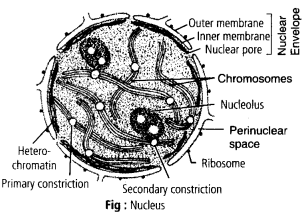
(ii) Centrosome: Centrosome is an organelle usually containing two cylindrical structures called centrioles. They are surrounded by amorphous pericentriolar materials. Both the centrioles in a centrosome lie perpendicular to each other. They are made up of nine evenly spaced peripheral fibrils of tubulin protein. Each of the peripheral fibril is a triplet. The adjacent triplets are also linked. The hub of centriole is connected with tubules of the peripheral triplets by radial spokes made of protein.
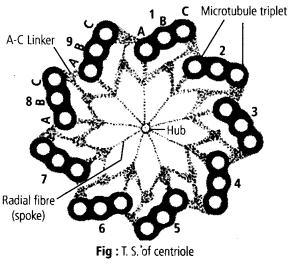
14.What is a centromere? How does the position of centromere form the basis of classification of chromosomes. Support your answer with a diagram showing the position of centromere on different types of chromosomes.
Soln
. A chromosome consists of two identical halves, the chromatids held together at one point called the centromere. The centromere is also called as primary constriction. On its side a disc shaped structure called kinetochore is present. Chromosomes are classified into four types according to position of centromere on the chromosome.
(i) Metacentric chromosome: In this chromosome, centromere is in the middle and the two arms are almost equal in length.
(ii)Submetacentric chromosome: The centromere is slightly away from middle point so one arm is slightly shorter than the other.
(iii)Acrocentric chromosome: The centromere is near the end and one arm is extremely short and other arm is extremely long.
(iv)Telocentric chromosome: Centromere is at the tip of chromosome. These chromosomes are not present in humans.
